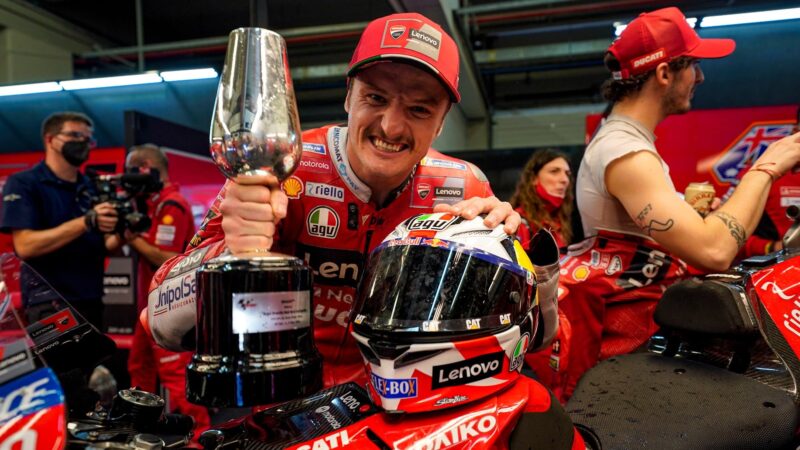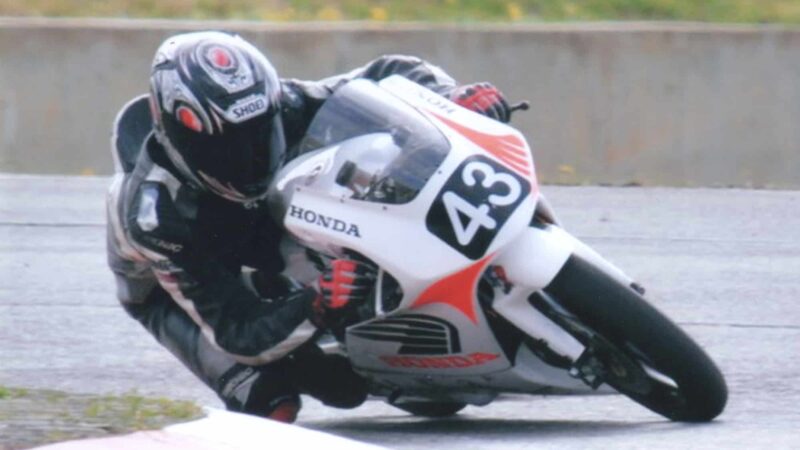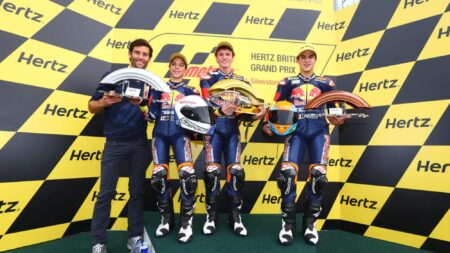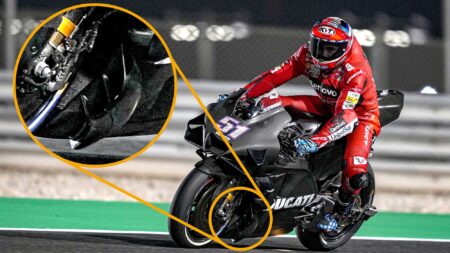Now fast forward: 2014 Moto3 title runner-up, HRC MotoGP rider from 2015, the Assen win, then the move to Ducati in 2018, when factory team boss Davide Tardozzi was already convinced that Miller has what it takes to follow Aussie forebears Troy Bayliss and Casey Stoner.
Miller signed for Ducati’s 2021 factory team last summer but had a horrible start to the new year: a deformed rear tyre in round one, arm-pump in round two and a tumble in round three which hurled him to the ground, exploding the stitches from the emergency arm-pump op he’d undergone after the second race.
Already the critics were circulating – including one former MotoGP champ – announcing he would never make it unless he tried harder.
Miller likes to enjoy life and in the past, he perhaps enjoyed himself too much but not anymore.
“I knew I couldn’t live that kind of lifestyle and be a successful motorbike rider,” he told me a couple of years back.
“Turn One on the slowdown lap was disbelief, Turn Two I started to cry, Turn Five I was screaming”
These days MotoGP is too fast, too close for riders to have much fun. They need to be pitiless on themselves: narrowing their focus to a pinpoint, stripping everything out of their lives until there’s nothing left apart from training to get their body ready for racing and thinking to get their mind ready.
The paddock is no longer a party place; hasn’t been for years. Old-school carousers like Barry Sheene wouldn’t even recognise the place.
“I’ve never been so strict and so narrow on myself,” Miller said at the start of last weekend. “I’m trying everything I can to turn the ship around and get the momentum coming back my way. I’ve never been so desperate to do it in my life. Sure I’ve been in worse shit before, but we’re in the shit at the moment, simple as that.
“Everything is there – the speed is there, everything is there, I just need to pull it all together. Time will tell if we can do it or not. I’m working on it I and I’ve got to try to do it.”
Finally it all came together on Sunday, when Miller scored Ducati’s first Jerez victory since 2006, chased to the finish line by team-mate Pecco Bagnaia for a rare Bolognese one-two.
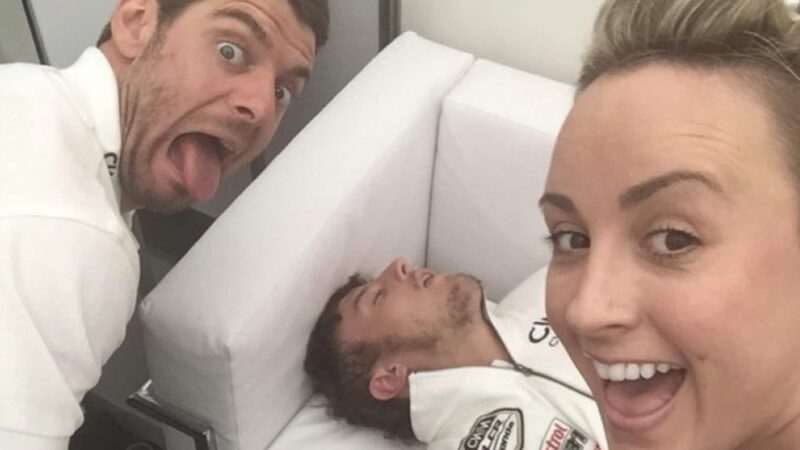
Cal and Lucy Crutchlow have been Miller’s biggest supporters since Cal and Jack rode together at LCR Honda
Crutchlow
When he took the chequered flag the memories of the last decade washing over him like a tidal wave of emotions.
“Turn One on the slowdown lap was disbelief, Turn Two I started to cry, Turn Five I was screaming,” he said. “Honestly I can’t believe it. You try something your whole life – the one thing you think about 90% of the time – and when it finally happens you don’t believe it, because you’ve been wrong so many times before.
“I’m sorry to look like a big softy on TV. I was trying to fight the tears but hearing everyone in pit lane clapping me I couldn’t hold back. I try to be the most genuine person I can be. I know a lot of people want me to do good, so it meant a lot today. Dreams come true – it’s f****** cool!”
Miller revealed that the person who played a significant part in the greatest success of his career so far was Lucy Crutchlow, wife of his closest racing friend Cal Crutchlow.
“The criticism I’ve had the last few weeks hasn’t been easy to live with. I’ve been angry, frustrated and not trusting myself. I’ll say one massive thing. I now have a new life coach. It used to be my mum but now it’s Lucy, calling me out the blue throughout the weekend, telling me, ‘You are fucking good! You can do it!’. Quite aggressive! So I have to say a massive thank you to her. It feels good to hear stuff like this because sometimes you need it because at the end of the day we are all human and we all have doubts.”
Although Ducati hadn’t won at Jerez since Loris Capirossi won the opening round of the 2006 championship Miller denied that Gigi Dall’Igna and his engineers have only just found the secret to winning there.
“We proved last year that this can be a Ducati track – [Andrea] Dovizioso and I were third and fourth in the first race here last year and Pecco could’ve won here if he hadn’t had that mechanical. This year’s bike is pretty similar and works pretty good around here.”
Miller spent much of the 25 laps chasing an on-fire Fabio Quartararo, who worked his way to the front so quickly and clinically that a third consecutive victory seemed assured. All Miller could do was give chase and use the Frenchman’s speed to pull him clear of the pack, so at least he could take his first podium of the year.
“I was thinking Fabio is going to demolish us, so I threw out the hook to get towed around for a few laps to get a decent enough gap, so I could wobble around for the last few laps and get a podium. Then he wasn’t going away anymore. The biggest surprise was when I came around the lap after I passed him. I saw +0.6 on my board – I thought, ‘you’re kidding!’”
This was Ducati’s first one-two since Brno 2018 when Dovizioso led Jorge Lorenzo over the line. This made Jerez an important day for Ducati, but could it be that the Bolognese factory now has its best rider MotoGP line-up? Certainly, the result vindicates the decision of Ducati chief engineer Gigi Dall’Igna to create an all-new team for 2021.
Miller is 26, Bagnaia only 24, and they both have their own ways to hustle the once recalcitrant Desmosedici around racetracks.
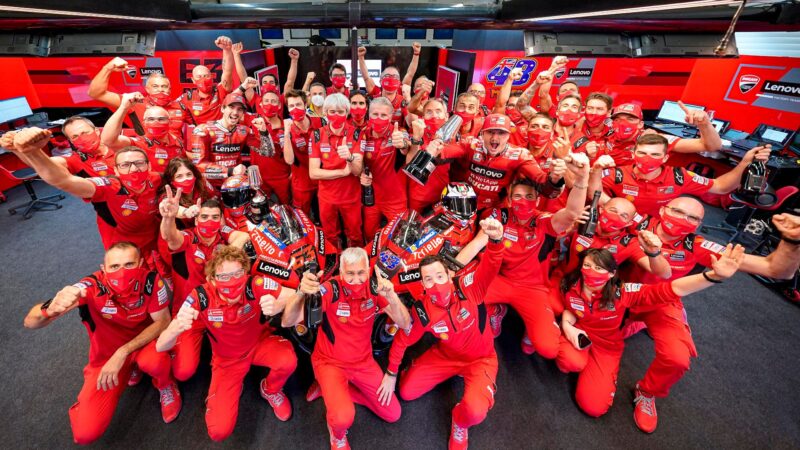
Ducati celebrates at Jerez on Sunday – is this the factory’s best-ever MotoGP team?
Ducati
After the race the pair discussed their different approaches to making the bike work – Miller uses the front end harder, Bagnaia the rear.
“We have two completely different set-ups but we ride quite the same,” said Bagnaia, who has yet to win his first MotoGP race. “I think I’m stronger in braking, because I can stop the bike very quickly, but maybe Jack is faster in corner entry. I sit more to the back of the bike.”
Miller’s style is more old-school. “I have to sit closer to the front of the bike because you see where I put my arse in the corners! Pecco leans out with his shoulder, while I go out with my arse, trying to be more like Mick Doohan. Pecco is more like modern era.”
Bagnaia’s main worry after the race was Sunday night – the team party. Miller may have learned the art of self-restraint but last night was going to be different, even if he is due to test at Jerez today.
“I’m going to drink about 30 beers and hopefully wake up without a hangover so I can ride tomorrow – nine before nine and you can wake up fine,” laughed Miller, while Bagnaia fidgeted nervously alongside.
“Tonight will be very difficult with Jack,” he grinned. “I remember Phillip Island a few years ago. We were together at the Sunday night party and he was very angry with me because I didn’t like the tequila and he wanted to give me tequila – I have to pay attention with him!”
Miller, Bagnaia and the Ducati certainly deserved a celebration last night, but it’s worth remembering that the real reason for their one-two was Quartararo’s arm pump, which had the Frenchman hanging on for dear life, lapping two seconds slower than his potential.
Arm pump is an affliction that has haunted motorcycle racers since the 1980s. The physical stresses of riding a 500cc GP bike or a MotoGP bike are so overwhelming that riders overuse certain muscles, causing those muscles to build and grow until they are constrained by the non-stretchy membranes that hold them in place. This restricts blood flow and then the problems begin.
